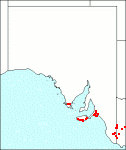Family: Orchidaceae
Microtis orbicularis
Citation:
R. Rogers, Trans. R. Soc. S. Aust. 31:63, t. 20, fig. I (1907).
Synonymy: Hydrorchis orbicularis Common name: None
Description:
A slender species, scape 15-30 cm high, green or pigmented red; leaf 5-20 cm long, 2-3 mm wide, acute, shorter than the spike, the fistula situated just below the latter at a characteristic angulation in the stem.
Spike with 3-30 almost sessile flowers not crowded, 1-5 cm long and spirally or alternately arranged; ovary ovoid, 2-3 x 1.5-2 mm, erect, standing well out from the spike; flowers erect, green, often with red tints, erect, thick-textured; dorsal sepal ovate, obtuse, 1.2-2 x 0.8-1.6 mm, galeate, gradually narrowing towards the base; lateral sepals linear, 0.5-1.2 x 0.2-0.4 mm, subacute, appressed to the ovary, concealed below the labellum; petals ovate-lanceolate, 1-2 x 0.6-1 mm, spreading below the dorsal sepal; labellum orbicular, 1.3-2.5 mm long and wide, pendulous, fleshy, margin entire, lamina somewhat concave, reflexed, without callosities, often with a small pit in the centre; column minute, 0.5-1 mm high, with minute conical fleshy auricles; rostellum protuberant as a dark-green beak; anther cucullate; pollinia attached to the rostellum by a rather long caudicle.
Published illustration:
Gray (1971) Victorian native orchids 2:5; Hoffman & Brown (1984) Orchids of south-west Australia, p. 240.
|
|
Distribution:
|
Occurs in areas which are inundated for up to six months of the year, such as waterholes, lake margins and shallow lagoons where very large populations may form. Known only from 5 locations in this State.
S.Aust.: EP, SL, KI, SE. W.Aust.; Vic.; Tas.
|
Conservation status:
native
Flowering time: Sept. — Nov.Fig. 969B.
|

SA Distribution Map based
on current data relating to
specimens held in the
State Herbarium of South Australia
|
Biology:
Plants normally flower when standing in water and the flower spikes are often submerged following spring rains so that the plant may be regarded as partly aquatic. S.Aust. forms are mainly apomictic.
Author:
Not yet available
|

